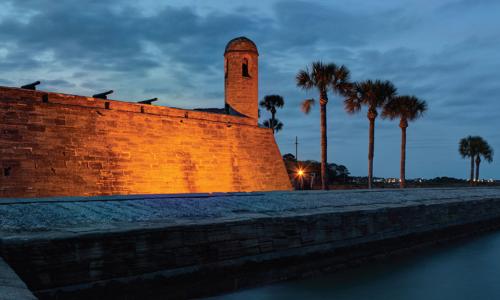This profile is excerpted from the 2014 report, National Landmarks at Risk: How Rising Seas, Floods, and Wildfires Are Threatening the United States' Most Cherished Historic Sites."
By commemorating the life of the legendary abolitionist, renowned for her courage and determination, the Harriet Tubman Underground Railroad National Monument promises to instill in visitors a deeper understanding of the Black experience of slavery and hard-won freedom.
On March 25, 2013—the centennial of Tubman’s death— President Barack Obama designated 25,000 acres on Maryland’s Eastern Shore as one of the nation’s newest monuments.
But this embodiment of Tubman’s antislavery legacy may be endangered by sea levels in the Chesapeake Bay, which have risen at almost twice the global rate because of climate change. The site could be largely underwater by 2050.
This imperiled land in Dorchester County is where Tubman was born into slavery in 1822 and toiled under oppressive masters, whose beatings caused her to suffer from chronic seizures throughout her life. She eventually escaped, at age 27, only to return to Maryland numerous times to rescue others and lead them north through thick weeds and marshes to freedom. This delivery of a great many of her people from bondage, via the network of secret routes and safe houses known as the Underground Railroad, earned her the nickname “Moses.”
“Harriet Tubman’s story is America’s story. She risked her life over and over again in the struggle against the evil of slavery. She lived by principles, strong faith in God, her love of family, and a belief in a better life,” said Chérie A. Butler, the National Park Service’s superintendent of the Tubman monument. “Ms. Tubman’s story is a testament that one determined person—no matter [her] station in life—can make a difference.”
The new monument fulfills the aspirations of many supporters who spent years pressing for a landmark to honor Tubman’s legacy as an abolitionist, nurse, and spy for the Union Army during the Civil War. A 2012 letter to the Department of the Interior requesting the national monument designation was signed by a bipartisan group of lawmakers that included the state’s Republican Representative Andy Harris and Democratic Senators Ben Cardin and Barbara A. Mikulski.
This achievement, however, may not be long-lived. Maryland, with more than 3,000 miles of tidal shoreline and low-lying rural and urban lands, is one of the states most vulnerable to sea level rise. Designating Tubman’s birthplace a national monument protects it from development but not from the rising seas off Maryland’s coast. Already, the waters of the Chesapeake Bay near the Tubman memorial have risen more than 10 inches over the past 70 years and may rise another 15 inches by 2050.
The Tubman monument is a vast expanse of marshes, fields, and forestlands that today remain much the same as when Tubman was alive. This status could change in the coming decades, as warming oceans increase the likelihood that tropical cyclones that survive the formation process will become Category 3, 4, or 5 storms—with the western North Atlantic (which abuts Maryland, among other states) being hit especially hard. Powerful storm surges riding on higher sea levels will be able to penetrate farther inland, causing more damage to the shoreline than the region has experienced for thousands of years.
Just weeks before the president announced the monument, Maryland broke ground on the 17-acre Harriet Tubman Underground Railroad State Park, which falls within the boundaries of the national monument and is expected to open in 2015 at a cost of $21 million.
Construction is under way on a 15,000-square-foot visitor center, designed with state-of-the-art systems for energy and water efficiency. Moreover, the center will purposely be placed on higher ground, and elevated as well, in recognition of the threat posed by rising sea levels.
But these measures may not be enough. The Tubman monument includes parts of the Blackwater National Wildlife Refuge, where wetlands at sea level are being lost to the rising ocean at the rate of about 300 acres a year. A 2002 study by the U.S. Geological Survey predicted that the refuge could be underwater by 2050—a loss that would deprive nearby communities of the critical protection against storms and sea level rise that the wetlands provide. This area also is home to one of the largest populations of nesting bald eagles on the Atlantic coast, as well as to numerous other bird and mammal species.
Efforts to limit sea level rise by reducing carbon emissions, as well as large-scale projects to restore wetlands, will be necessary to ensure that this landscape remains not only an important national symbol—of our country’s checkered history of securing civil rights for all of its people—but also that it remains a vital part of the economy of Maryland’s Eastern Shore.




